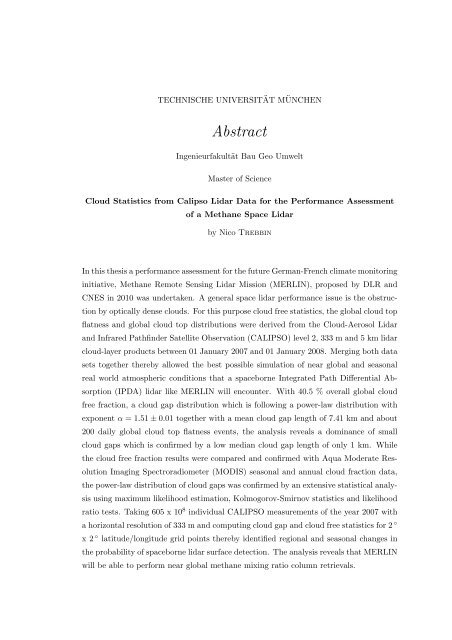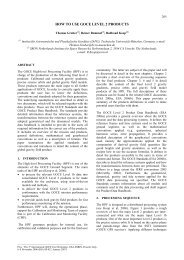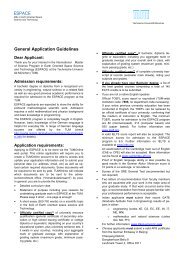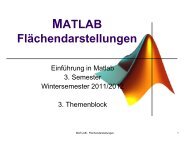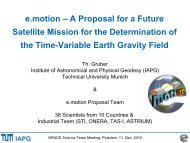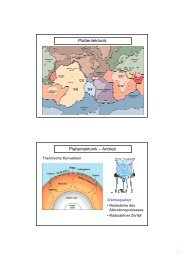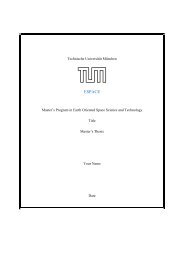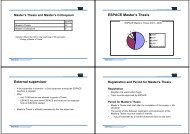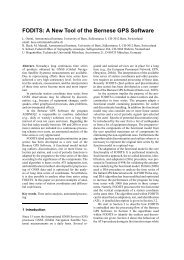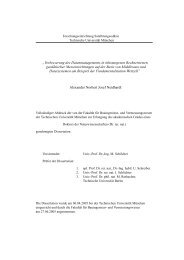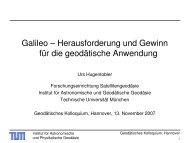Cloud Statistics from Calipso Lidar Data for the ... - espace-tum.de
Cloud Statistics from Calipso Lidar Data for the ... - espace-tum.de
Cloud Statistics from Calipso Lidar Data for the ... - espace-tum.de
You also want an ePaper? Increase the reach of your titles
YUMPU automatically turns print PDFs into web optimized ePapers that Google loves.
TECHNISCHE UNIVERSITÄT MÜNCHEN<br />
Abstract<br />
Ingenieurfakultät Bau Geo Umwelt<br />
Master of Science<br />
<strong>Cloud</strong> <strong>Statistics</strong> <strong>from</strong> <strong>Calipso</strong> <strong>Lidar</strong> <strong>Data</strong> <strong>for</strong> <strong>the</strong> Per<strong>for</strong>mance Assessment<br />
of a Methane Space <strong>Lidar</strong><br />
by Nico Trebbin<br />
In this <strong>the</strong>sis a per<strong>for</strong>mance assessment <strong>for</strong> <strong>the</strong> future German-French climate monitoring<br />
initiative, Methane Remote Sensing <strong>Lidar</strong> Mission (MERLIN), proposed by DLR and<br />
CNES in 2010 was un<strong>de</strong>rtaken. A general space lidar per<strong>for</strong>mance issue is <strong>the</strong> obstruction<br />
by optically <strong>de</strong>nse clouds. For this purpose cloud free statistics, <strong>the</strong> global cloud top<br />
flatness and global cloud top distributions were <strong>de</strong>rived <strong>from</strong> <strong>the</strong> <strong>Cloud</strong>-Aerosol <strong>Lidar</strong><br />
and Infrared Pathfin<strong>de</strong>r Satellite Observation (CALIPSO) level 2, 333 m and 5 km lidar<br />
cloud-layer products between 01 January 2007 and 01 January 2008. Merging both data<br />
sets toge<strong>the</strong>r <strong>the</strong>reby allowed <strong>the</strong> best possible simulation of near global and seasonal<br />
real world atmospheric conditions that a spaceborne Integrated Path Differential Absorption<br />
(IPDA) lidar like MERLIN will encounter. With 40.5 % overall global cloud<br />
free fraction, a cloud gap distribution which is following a power-law distribution with<br />
exponent α = 1.51 ± 0.01 toge<strong>the</strong>r with a mean cloud gap length of 7.41 km and about<br />
200 daily global cloud top flatness events, <strong>the</strong> analysis reveals a dominance of small<br />
cloud gaps which is confirmed by a low median cloud gap length of only 1 km. While<br />
<strong>the</strong> cloud free fraction results were compared and confirmed with Aqua Mo<strong>de</strong>rate Resolution<br />
Imaging Spectroradiometer (MODIS) seasonal and annual cloud fraction data,<br />
<strong>the</strong> power-law distribution of cloud gaps was confirmed by an extensive statistical analysis<br />
using maximum likelihood estimation, Kolmogorov-Smirnov statistics and likelihood<br />
ratio tests. Taking 605 x 10 8 individual CALIPSO measurements of <strong>the</strong> year 2007 with<br />
a horizontal resolution of 333 m and computing cloud gap and cloud free statistics <strong>for</strong> 2 ◦<br />
x 2 ◦ latitu<strong>de</strong>/longitu<strong>de</strong> grid points <strong>the</strong>reby i<strong>de</strong>ntified regional and seasonal changes in<br />
<strong>the</strong> probability of spaceborne lidar surface <strong>de</strong>tection. The analysis reveals that MERLIN<br />
will be able to per<strong>for</strong>m near global methane mixing ratio column retrievals.


